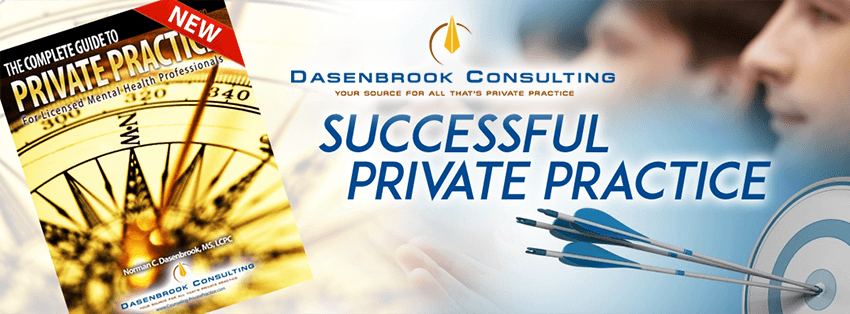The successful mental health professional in private practice is not only well trained, but understands that private practice is a business.
Yes, a business!
If you had a product or widget for sale that could help a child communicate better with a parent, diagnose depression or anxiety, treat OCD or panic disorder, keep a family from falling apart or help a person see options to suicide, that would be a very valuable product. Wouldn’t it?
That product or widget is you. But if you fail at business, clients cannot profit from your skills or gifts.
If you can’t make a good living in private practice, your therapy will suffer and clients cannot benefit from your skill set. For the mental health professional just starting to the large group practice, thriving practices take risks, change paradigms and differentiate themselves from the competition.
There is nothing easy or simple about it. It takes time, dedication, money, risk of failure, good sound clinical training, experience and a Marketing Plan.
Two Prong Marketing Plan
Perhaps you have seen or purchased other practice building materials that make bold promises such as, “3 Easy Methods to Build a Cash Only Practice” or “The 5 Simple Steps to a be a Wealthy Therapist” etc.
Developing an ongoing marketing plan is essential to any business, and therapy is no different. Not only do you need to launch a practice, but you also need to make that practice self-sustaining. Codes of ethics provide some guidance in this area but are not overly helpful. Common sense and a professional approach will help you market yourself directly to clients and referral sources.
A great marketing plan (two prong approach) will directly target:
- The potential client.
- Those individuals and services (potential referral sources) that come in contact with potential clients.
Marketing consultants will tell you that repetition is important. Do not plan one or two big marketing projects; think smaller efforts conducted more often. As you look at the marketing components in this article, decide which would be appropriate for your practice, which would target the client directly and which ones would target referral sources to develop your plan.
We know that marketing directly to the client is effective by just watching TV commercials. Pharmaceutical companies learned this long ago by targeting their products directly to the patient. Rather than just market physicians and health care systems they went right to the consumer. We should learn from this.
Example, a marketing plan to target clients might include:
- Article or Column in Local Newspaper
- Web Presence
- Website
- Blogs
- Professional Facebook Page
- YouTube videos
- Online Therapist Directory
- Professional Organizations
- Review sites like Yelp.com
- Brown Bag Speeches
- Media Interviews
- Support Groups
- Newsletter
Example, a marketing plan to target potential referrals
- Identify Niche
- Identify Area Business
- Social Media
- Email Newsletter
- Separate Websites for Different Income Streams
- Presenting for Business Groups and Societies
To target potential referral sources, make a list of individuals, agencies and organizations that come in contact with the type of clients (niche) you want to treat. For example, if your niche is treating adolescents, you might wish to prospect:
- Pediatricians and family physicians
- Middle and high schools
- School principals
- School counselors and social workers
- Employee assistance programs
- Probation departments
- Police departments
- United Way agencies
- Churches
- Community mental health centers
- Community centers
- Parent support groups
- Substance abuse treatment centers
- Other therapists who only treat children or adults
Send a letter of introduction along with your promotional pieces. Follow up with a phone call to confirm they received your information and try to schedule a meeting.
One major resource for marketing opportunities that is usually overlooked by mental health professionals is business and industry. There are two ways to market to business and industry: directly, usually through the human resource department, or indirectly to others that already have access, such as employee assistance programs (EAPs) or private consultants/trainers.
Identify the top 10 businesses in your area and the name of the HR Directors and “snail mail” a letter of introduction and your brochure detailing what services you provide and what you can provide for his/her company and employees.
Follow up with a phone call to the vice president of human resources at each. Introduce yourself and ask who provides their employee assistance program services and mental health coverage. If they are interested, schedule a meeting to discuss the possibilities or invite them to lunch.
Work groups are nothing more than families who suffer from the same things as nuclear families. Think of yourself as an expert in human behavior and human relations, and then take what you know about family therapy and market it to the business community. They pay—and they pay well.
These professionals need speakers on such topics as:
- Conflict management
- Strategic planning
- Customer relations
- Coaching vs. supervising
- Stress management
- Dealing with troubled employees
- Workplace violence
- Diversity
- Harassment
The list could go on. Also, if you have the experience, offer to provide employee assistance program services. Supply references from other talks or presentations you have given.


